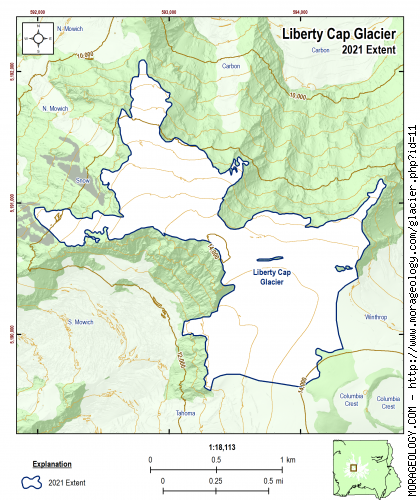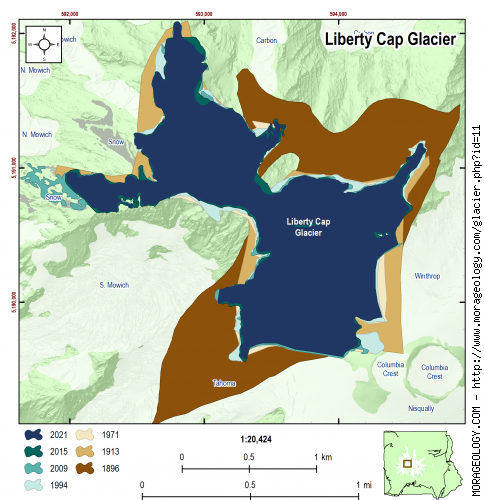NOTE: The data shown here is based on the 2021 glacier update at Mount Rainier, and should be considered the most up-to-date data on glaciers at the park (2023-04-06).
Liberty Cap Glacier
Liberty Cap is the northern peak of the summit of Mount Rainier with an elevation of 14,112 feet. Bailey Willis named it in 1883 for '....its fanciful resemblance to the head and cap of the Goddess of Liberty...' Dee Molenaar reports that it had previously been called North Peak for its location. (Reese, 2009)
Switch Glacier:

|
STATISTICS AS OF 2021 (Beason et al., 2023):
Aerial Extent:
0.801 ± 0.045 square miles
(2.076 ± 0.116 km2)
(Rank: 13 of 29)
Debris Cover - Based on data from 2015 (Beason, 2017):
--No appreciable debris cover in 2015--
Estimated Glacier Volume: (See notes below)
0.0200 ± 0.0070 cubic miles
(0.0833 ± 0.0292 km3)
Highest Elevation (Head):
14,088 feet
(4,294 m)
Lowest Elevation (Terminus):
10,565 feet
(3,220 m)
Elevation Range:
3,523 feet
(1,074 m)
Length:
1.69 miles
(2.71 km)
Average Slope:
28.82°
Average Flow Direction (direction the glacier flows towards):
Southwest (233°)
Glacier Type:
S - Glacier Head Near Summit |

|
CHANGE IN EXTENT, 1896-2021 (Beason et al., 2023):
| Units |
1896 |
1913 |
1971 |
1994 |
2009 |
2015 |
2021 |
| Area, mi2 |
1.090 |
0.927 |
0.803 |
0.812 |
0.849 |
0.826 |
0.801 |
| Area, km2 |
2.822 |
2.401 |
2.079 |
2.102 |
2.200 |
2.139 |
2.076 |
Area Change Between Periods
|
1913 |
1971 |
1994 |
2009 |
2015 |
2021 |
| 1896 | -0.163 mi2
(-0.422 km2) | -0.287 mi2
(-0.743 km2) | -0.278 mi2
(-0.721 km2) | -0.240 mi2
(-0.623 km2) | -0.264 mi2
(-0.684 km2) | -0.288 mi2
(-0.747 km2) |
|---|
| 1913 | -- | -0.124 mi2
(-0.321 km2) | -0.115 mi2
(-0.299 km2) | -0.078 mi2
(-0.201 km2) | -0.101 mi2
(-0.262 km2) | -0.126 mi2
(-0.325 km2) |
|---|
| 1971 | | -- | 0.009 mi2
(0.023 km2) | 0.046 mi2
(0.120 km2) | 0.023 mi2
(0.059 km2) | -0.001 mi2
(-0.004 km2) |
|---|
| 1994 | | | -- | 0.038 mi2
(0.098 km2) | 0.014 mi2
(0.037 km2) | -0.010 mi2
(-0.026 km2) |
|---|
| 2009 | | | | -- | -0.024 mi2
(-0.061 km2) | -0.048 mi2
(-0.124 km2) |
|---|
| 2015 | | | | | -- | -0.024 mi2
(-0.063 km2) |
|---|
Percent Change Between Periods
|
1913 |
1971 |
1994 |
2009 |
2015 |
2021 |
| 1896 | -14.94% | -26.33% | -25.53% | -22.06% | -24.22% | -26.46% |
|---|
| 1913 | -- | -13.39% | -12.45% | -8.37% | -10.92% | -13.54% |
|---|
| 1971 | | -- | 1.08% | 5.79% | 2.85% | -0.18% |
|---|
| 1994 | | | -- | 4.66% | 1.75% | -1.25% |
|---|
| 2009 | | | | -- | -2.78% | -5.64% |
|---|
| 2015 | | | | | -- | -2.95% |
|---|
|
|
ESTIMATED CHANGE IN VOLUME, 1896-2021 (Beason et al., 2023):
PLEASE see important notes about this, below...
Glacier-specific Scaling Parameter, c:
0.035821
| Units |
1896 |
1913 |
1971 |
1994 |
2009 |
2015 |
2021 |
| Volume, mi3 |
0.0304 |
0.0244 |
0.0200 |
0.0203 |
0.0216 |
0.0208 |
0.0200 |
| Volume, km3 |
0.1269 |
0.1017 |
0.0835 |
0.0848 |
0.0902 |
0.0868 |
0.0833 |
Volume Change Between Periods
|
1913 |
1971 |
1994 |
2009 |
2015 |
2021 |
| 1896 | -0.006 mi3
(-0.025 km3) | -0.010 mi3
(-0.043 km3) | -0.010 mi3
(-0.042 km3) | -0.009 mi3
(-0.037 km3) | -0.010 mi3
(-0.040 km3) | -0.010 mi3
(-0.044 km3) |
|---|
| 1913 | -- | -0.004 mi3
(-0.018 km3) | -0.004 mi3
(-0.017 km3) | -0.003 mi3
(-0.011 km3) | -0.004 mi3
(-0.015 km3) | -0.004 mi3
(-0.018 km3) |
|---|
| 1971 | | -- | 0.000 mi3
(0.001 km3) | 0.002 mi3
(0.007 km3) | 0.001 mi3
(0.003 km3) | 0.000 mi3
(0.000 km3) |
|---|
| 1994 | | | -- | 0.001 mi3
(0.005 km3) | 0.000 mi3
(0.002 km3) | 0.000 mi3
(-0.001 km3) |
|---|
| 2009 | | | | -- | -0.001 mi3
(-0.003 km3) | -0.002 mi3
(-0.007 km3) |
|---|
| 2015 | | | | | -- | -0.001 mi3
(-0.003 km3) |
|---|
Percent Change Between Periods
|
1913 |
1971 |
1994 |
2009 |
2015 |
2021 |
| 1896 | -19.87% | -34.18% | -33.20% | -28.91% | -31.59% | -34.34% |
|---|
| 1913 | -- | -17.86% | -16.64% | -11.28% | -14.63% | -18.06% |
|---|
| 1971 | | -- | 1.49% | 8.01% | 3.93% | -0.25% |
|---|
| 1994 | | | -- | 6.43% | 2.41% | -1.71% |
|---|
| 2009 | | | | -- | -3.78% | -7.64% |
|---|
| 2015 | | | | | -- | -4.02% |
|---|
Important comments about the calculation of volume shown here
The calculation of glacial volume shown on this page is based on an analysis of two methods used at Mount Rainier in the past (Driedger and Kennard [1986]; and Nylen [2001]) as well as the most recent literature review for glacier area-volume scaling (Please review Beason et al. [2023] for an in-depth discussion about this issue). It should be noted that simply converting area to volume with an equation is extremely difficult and the values presented here have extremely large error margins (likely ± 35% or more). With that in mind, the values presented here should give you an estimate of the glacial volume and change in volume over time. Please use these data very carefully with those caveats.
The calcuation of the volume is as follows:
\[V_i = {(c_iA_i^{1.375}) + (c_nA_i^{1.36}) \over 2}\]
Where:
\(V_i\) = Average volume for the glacier in question (km3);
\(c_i\) = The glacier-specific scaling parameter (back-calculated from glacier area and volume in 1971 in Driedger and Kennard (1986); Method described in Beason et al. (2023). The value for the Liberty Cap Glacier is 0.035821 (this is also listed above the volume graph);
\(c_n\) = The back-calculated scaling parameter from Nylen (2001) of 0.0255; and
\(A_i\) = The measured volume of the glacier in question (km2).
This is essentially an average of the back-calculated Dreidger and Kennard (1986) and Nylen (2001) methods (D&K is in the first parenthesis; Nylen in the second). For example, for the Liberty Cap Glacier in 2021, you can find the following individual volumes:
Back-calculated Dreidger and Kennard (1986) Method: 0.0235 mi3 (0.0978 km3).
Back-calculated Nylen (2001) Method: 0.0165 mi3 (0.0688 km3).
Average of the two (above equation and values listed for 2021 here): 0.0200 mi3 (0.0833 km3).
Official volume estimate listed above, with error: 0.0200 ± 0.0070 mi3 (0.0833 ± 0.0292 km3).
As you can see, the D&K method tends to produce higher values and Nylen produces lower values; the average of these two methods probably estimates the glacial volume. Until further research is done in this area and we can develop a better method or equation to determine volumes, this is the method we are using to determine glacial volumes. For more information about this method, please read the methods section of Beason et al. (2023).
|
NOTES:
This glacier flows into the Carbon, North Mowich, Edmunds, and South Mowich Glaciers
RAW DATA: